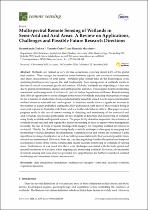| dc.contributor.author | Gxokwe, Siyamthanda | |
| dc.contributor.author | Dube, Timothy | |
| dc.contributor.author | Mazvimavi, Dominic | |
| dc.date.accessioned | 2023-07-14T14:01:46Z | |
| dc.date.available | 2023-07-14T14:01:46Z | |
| dc.date.issued | 2022 | |
| dc.identifier.citation | Gxokwe, S., Dube, T. and Mazvimavi, D., 2020. Multispectral remote sensing of wetlands in semi-arid and arid areas: a review on applications, challenges and possible future research directions. Remote Sensing, 12(24), p.4190. | en_US |
| dc.identifier.uri | https://doi.org/10.3390/rs12244190 | |
| dc.identifier.uri | http://hdl.handle.net/10566/9205 | |
| dc.description.abstract | Wetlands are ranked as very diverse ecosystems, covering about 4–6% of the global land surface. They occupy the transition zones between aquatic and terrestrial environments, and share characteristics of both zones. Wetlands play critical roles in the hydrological cycle, sustaining livelihoods and aquatic life, and biodiversity. Poor management of wetlands results in the loss of critical ecosystems goods and services. Globally, wetlands are degrading at a fast rate due to global environmental change and anthropogenic activities. This requires holistic monitoring, assessment, and management of wetlands to prevent further degradation and losses. Remote-sensing data offer an opportunity to assess changes in the status of wetlands including their spatial coverage. So far, a number of studies have been conducted using remotely sensed data to assess and monitor wetland status in semi-arid and arid regions. | en_US |
| dc.language.iso | en | en_US |
| dc.publisher | Remote Sensing | en_US |
| dc.subject | Data integration | en_US |
| dc.subject | Inundation | en_US |
| dc.subject | Multispectral imagery | en_US |
| dc.subject | Semi-arid | en_US |
| dc.subject | Seasonal wetlands | en_US |
| dc.title | Multispectral remote sensing of wetlands in semi-arid and arid areas: A review on applications, challenges and possible future research directions | en_US |
| dc.type | Article | en_US |

